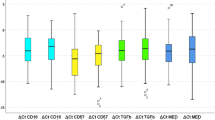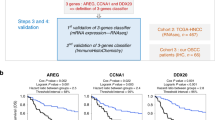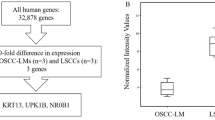Abstract
Maspin, a member of the serpin family of protease inhibitors, is known to have tumor-suppressor functions. However, the association between its expression level and survival has not been demonstrated in human cancer. Using the immunohistochemical technique to examine the expression levels of maspin in 44 cases of oral squamous cell carcinoma (SCC), we found that 66% of the cases expressed low to intermediate levels of maspin and 34% of the cases expressed high levels of maspin. We further examined maspin protein expression in a series of six SCC cell lines from the head and neck, and found that all but one expressed low or no maspin protein. We also compared the clinicopathological features of the oral SCC cases with the maspin expression level, and found that high maspin expression was associated with the absence of lymph node metastasis. More importantly, we showed that higher maspin expression was significantly associated with better rates of overall survival, suggesting that high maspin expression may be a favorable prognostic marker for oral SCC.
This is a preview of subscription content, access via your institution
Access options
Subscribe to this journal
Receive 50 print issues and online access
$259.00 per year
only $5.18 per issue
Buy this article
- Purchase on Springer Link
- Instant access to full article PDF
Prices may be subject to local taxes which are calculated during checkout




Similar content being viewed by others
References
Ahomadegbe JC, Barrois M, Fogel S, Le Bihan ML, Douc-Rasy S, Duvillard P, Armand JP and Riou G . 1995 Oncogene 10: 1217–1227
Berenson JR, Yang J and Mickel RA . 1989 Oncogene 4: 1111–1116
Field JK, Spandidos DA, Stell PM, Vaughan ED, Evan GI and Moore JP . 1989 Oncogene 4: 1463–1468
Pemberton PA, Tipton AR, Pavloff N, Smith J, Erickson JR, Mouchabeck ZM and Kiefer MC . 1997 J Histochem Cytochem 45: 1697–1706
Sager R, Sheng S, Pemberton P and Hendrix MJ . 1996 Curr Topics Microbiol Immunol 213: 51–64
Sheng S, Carey J, Seftor EA, Dias L, Hendrix MJ and Sager R . 1996 Proc Natl Acad Sci USA 93: 11669–11674
Sheng S, Pemberton PA and Sager R . 1994 J Biol Chem 269: 30988–30993
Sheng S, Truong B, Fredrickson D, Wu R, Pardee AB and Sager R . 1998 Proc Natl Acad Sci USA 95: 499–504
Somers KD, Merrick MA, Lopez ME, Incognito LS, Schechter GL and Casey G . 1992 Cancer Res 52: 5997–6000
Sternlicht MD, Kedeshian P, Shao ZM, Safarians S and Barsky SH . 1997 Clin Cancer Res 3: 1949–1958
Umekita Y, Hiipakka RA and Liao S . 1997 Cancer Lett 113: 87–93
Watling DL, Gown AM and Coltrera MD . 1992 Head & Neck 14: 437–444
Xia W, Lau Y-K, Zhang H-Z, Liu A-R, Kiyokawa N, Clayman GL, Katz RL and Hung M-C . 1997 Clin Cancer Res 3: 3–9
Yamamoto T, Kamata N, Kawano H, Shimizu S, Kuroki T, Toyoshima K, Rikimaru K, Nomura N, Ishizaki R, Pastan I, Gamou S and Shimizu N . 1986 Cancer Res 46: 414–416
Zhang M, Maass N, Magit D and Sager R . 1997a Cell Growth Differ 8: 179–186
Zhang M, Magit D and Sager R . 1997b Proc Natl Acad Sci USA 94: 5673–5678
Zou Z, Anisowicz A, Hendrix MJ, Thor A, Neveu M, Sheng S, Rafidi K, Seftor E and Sager R . 1994 Science 263: 526–529
Acknowledgements
We thank Dr Douglas Boyd for generously providing the human keratinocyte cell line. This study was supported in part by MD Anderson Faculty Achievement Award (to M-C Hung), and MD Anderson Nellie Connally Breast Cancer Research Fund (to M-C Hung).
Author information
Authors and Affiliations
Rights and permissions
About this article
Cite this article
Xia, W., Lau, YK., Hu, MT. et al. High tumoral maspin expression is associated with improved survival of patients with oral squamous cell carcinoma. Oncogene 19, 2398–2403 (2000). https://doi.org/10.1038/sj.onc.1203535
Received:
Revised:
Accepted:
Published:
Issue Date:
DOI: https://doi.org/10.1038/sj.onc.1203535
Keywords
This article is cited by
-
Systems-level differential gene expression analysis reveals new genetic variants of oral cancer
Scientific Reports (2020)
-
Recombinant human maspin inhibits high glucose-induced oxidative stress and angiogenesis of human retinal microvascular endothelial cells via PI3K/AKT pathway
Molecular and Cellular Biochemistry (2018)
-
Active nuclear IKK correlates with metastatic risk in cutaneous squamous cell carcinoma
Archives of Dermatological Research (2015)
-
Nuclear location of tumor suppressor protein maspin inhibits proliferation of breast cancer cells without affecting proliferation of normal epithelial cells
BMC Cancer (2014)
-
Role of maspin in cancer
Clinical and Translational Medicine (2013)



